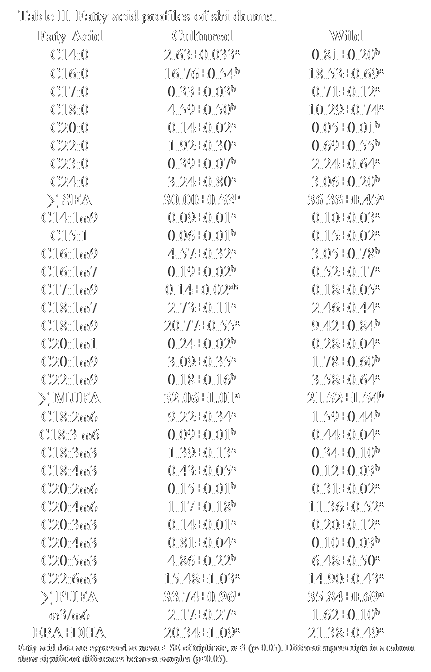PROXIMATE COMPOSITION AND FATTY ACID PROFILE OF CULTURED AND WILD SHI DRUM (Umbrina cirrosa) IN ANTALYA, TURKEY.
Introduction
A number of fatty acids cannot be synthesised by human body. These essential fatty acids must be consumed in the diet. Polyunsaturated fatty acids (PUFAs) are essential for normal growth and development and they may have an important role in many aspects of human health (Gonzales et al., 2006; Nasopoulou et al., 2007).
Intensive production of fish in different culture conditions raised concerns of consumers over the quality of these fish on the market. The nutritional values of fish grown in different intensive culture conditions and caught from the nature are questioned by the consumers. Shi drum (Umbrina cirrosa) is one of the economically important fish species in Turkey has begun to be cultivated in recent years and it has been preferred by the consumers due to its quality and desirable aroma. Therefore the objective of this study was to investigate proximate composition and fatty acid profile of cage-cultured and wild shi drums.
Materials and Methods
The experiment was carried out using female cage-cultured from commercial company and wild fish obtained from local fisherman (province of Antalya, Turkey). The each group of fish contained ten specimen and the average weights of the samples were 1000±122.17 g for cultured, 378±40.24 g for wild samples. Standard sea bream feed was used for shi drum.
After their sex was determined, all samples were stored in freezer (-18 oC) and analyses were carried out in triplicates, using homogenized boneless fish fillets. Moisture, crude protein and ash contents were determined by the methods of AOAC (1990) and lipid content was analyzed according to the method of Bligh and Dyer (1959). The fatty acid composition was analyzed by a GC Clarous 500 with autosampler (Perkin-Elmer, USA).
Results
Proximate compositions of cage-cultured and wild samples of shi drum are shown in table I. While there was not any statistical difference protein and ash levels of cultured and wild shi drums, lipid level of cultured group was significantly higher than that of wild fish.
The results showed that (Table II.), the saturated fatty acid (SFA), monounsaturated fatty acid (MUFA) and PUFA amounts of cultured and wild shi drum was significantly different. While SFA and PUFA were higher in wild group, MUFA was lower. However ω3/ω6 ratio was higher in cultured group.
Discussion
Although there was no any difference in protein level, lipid level of cultured samples was significantly higher similar to some previous findings. In some previous studies it was opined that the feed offered to farmed specimen had direct impact on its body fat increments (Ashraf et al., 2011).
The fatty acid composition of fish differs depending on a variety of factors including species, diet, environmental factors such as salinity, temperature, season, geographical location and whether they are farmed or wild (Belinda et al., 2000; Gonzales et al., 2006).
Either SFA or PUFA in the current study were higher statistically in wild group of fish. However cultivated shi drum had notably higher level of MUFA. The higher levels of MUFA in the cultured fish may be explained with the high content of monoenoic fatty acids in the feed of cultured fish as in some other species (Fuentes et al., 2010).
The ω3/ω6 ratio is a good index for comparing relative nutritional value of fish oils. However, there is no recommended intake in terms of ω3/ω6 ratios but evidence in wild animals and estimated nutrient intake during human evolution suggest a diet ratio 1:1 (Simolopoulos, 1989). The cultured shi drum appears to be better nutritious in terms of ω3/ω6.
Acknowledgement
This work was supported by the Scientific Research Project Unit of the University of Cukurova, Turkey under grant no SUF2013BAP13
References
AOAC. 1995. Official methods of analysis. 16.th Ed., Assoc. Of Official Analytical Chemists, Wasington DC.
Ashraf, M., A. Zafar, A. Rauf, S. Mehboob and N.A. Qureshi, 2011. Nutritional values of wild and cultivated silver carp (Hypophthalmichthys molitrix) and grass carp (Ctenopharyngodon idella). Int. J. Agric. Biol., 13: 210-214
Bligh, E.G., Dyer, W.J. 1959. A rapid method of total lipid extraction and purification. Can. J. Biochem. Phys. 37, 911-917.
Belinda, J. H., Ed, B., Roberts, D. CK. 2000. Potential impact of the fat composition of farmed fish on human health. Nutritional Research., 20, (7): 1047-1058.
Fuentes, A., Fernandez-Segovia, I., Serra, J.A., Barat, J.M. 2010. Comparison of wild and cultured sea bass (Dicentrarchus labrax) quality. Food Chemistry, 119: 1514 - 1518.
Gonzales, S., Flick, G. J., O'keefe, S. F., Duncan, S. E., Mclean, E. and Graig, S. R. 2006. Composition farmed and wild yellow perch (Perca flavescens). J. Food Compos. Anal., 19: 720-726.
Nasopoulou, C., Nomikos, T., Demopoulos, C. A. And Zabetakis, I. 2007. Comparison of antiatherinogenic properties of lipids obtained from wild and cultured sea bass (Dicentrarchus labrax) and gilthead sea bream (Sparus aurata). Food Chem., 100: 560-567.
Simolopoulos, A., P 1989. Summary of NATO advanced research workshop on dietery n-3 and n-6 fatty acids: Biologycal effects nutritional essentiality. Journol of Nutrition., 199: 512 - 528.

